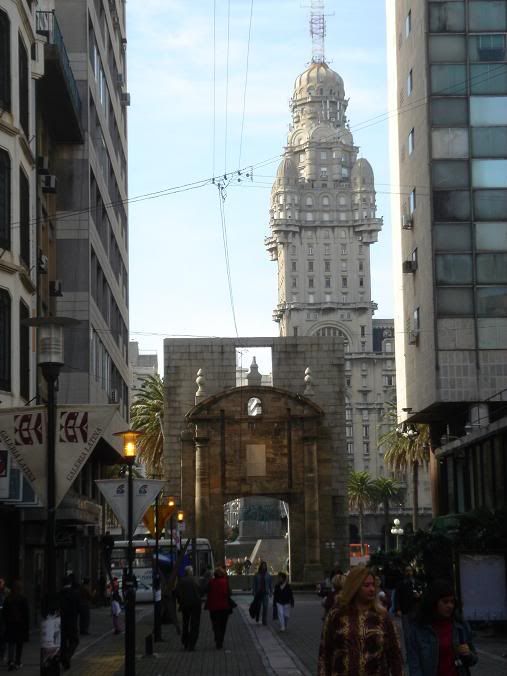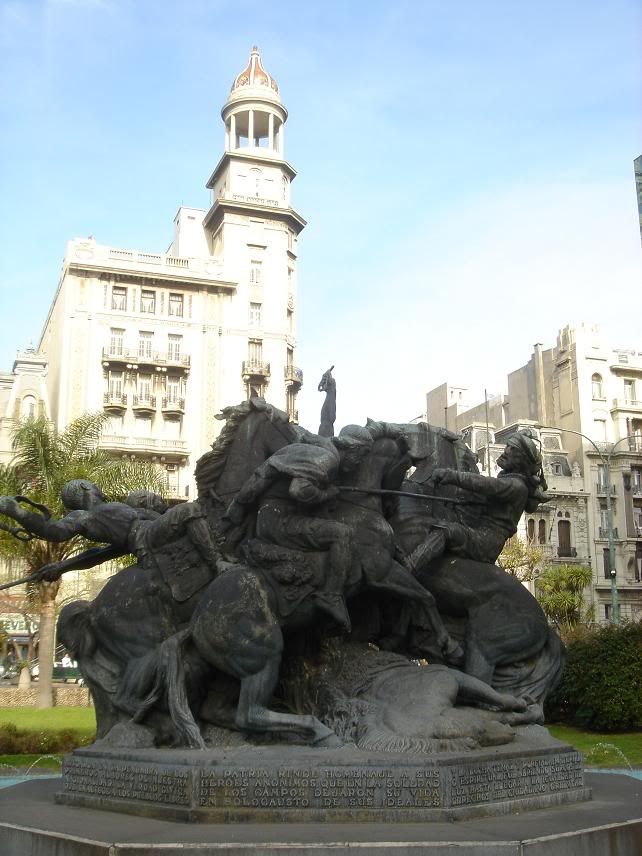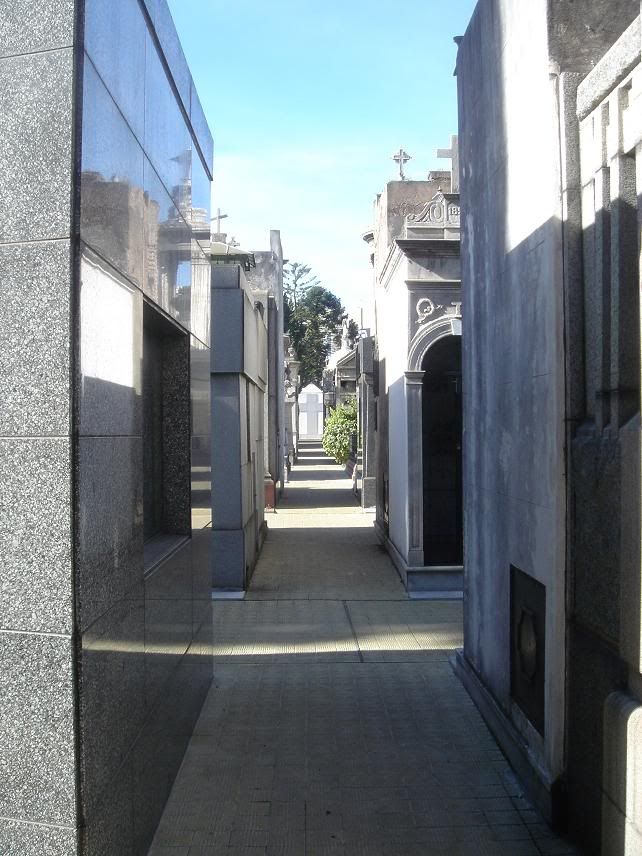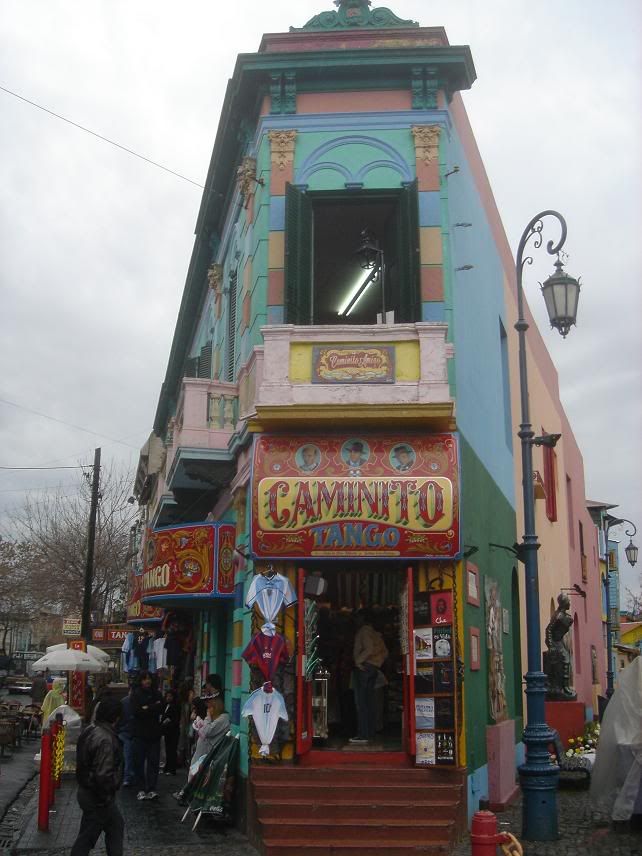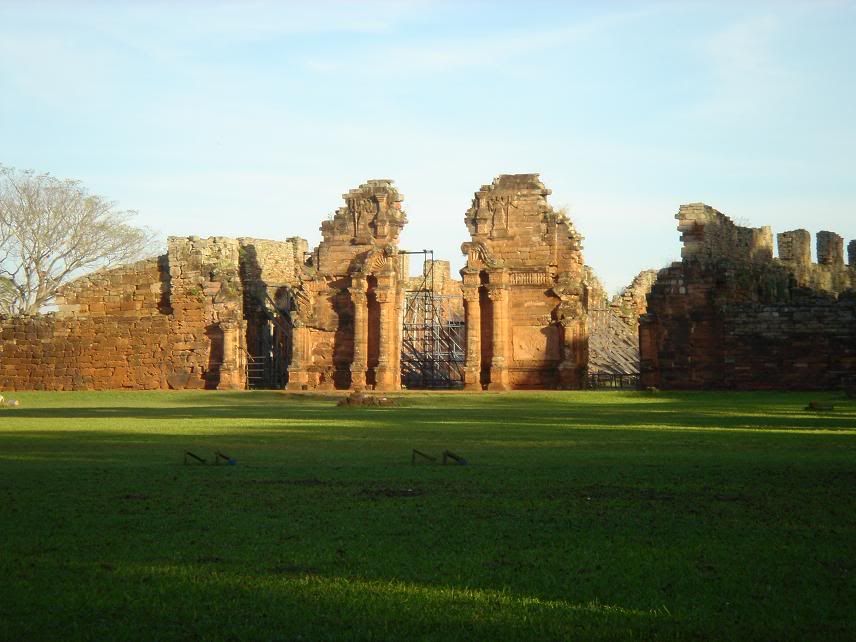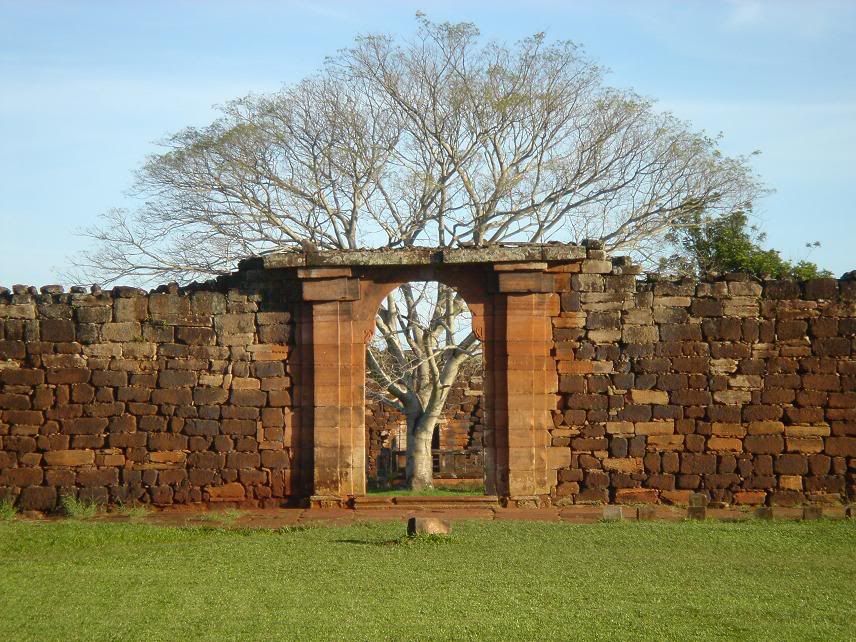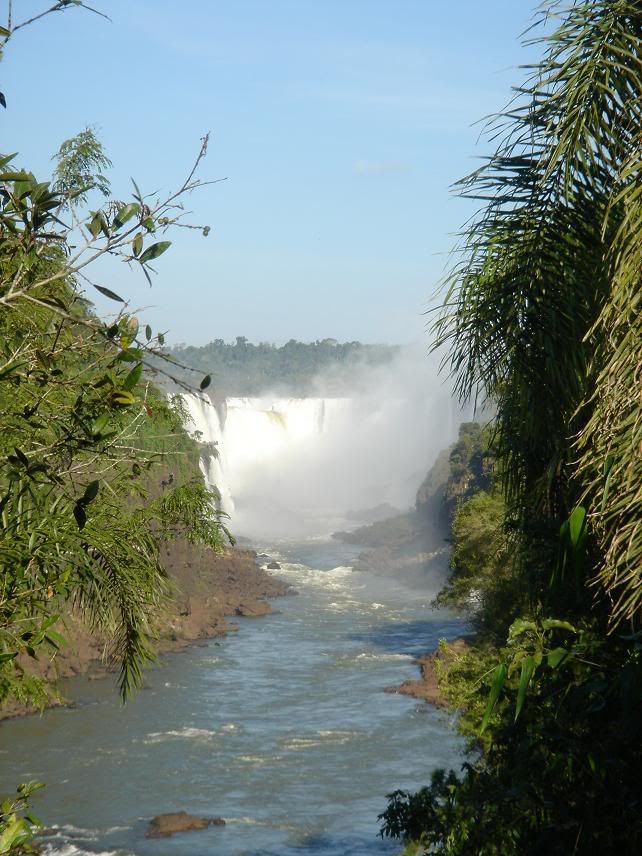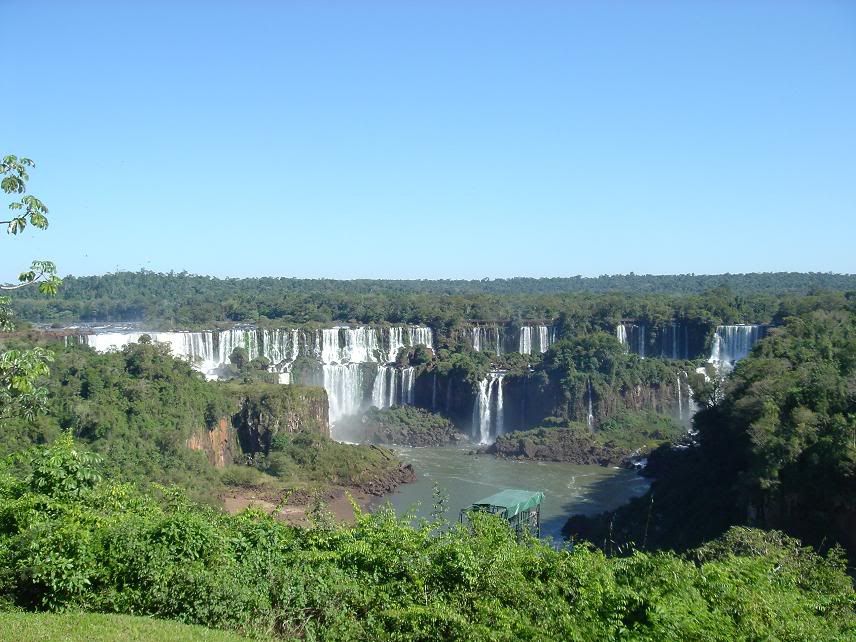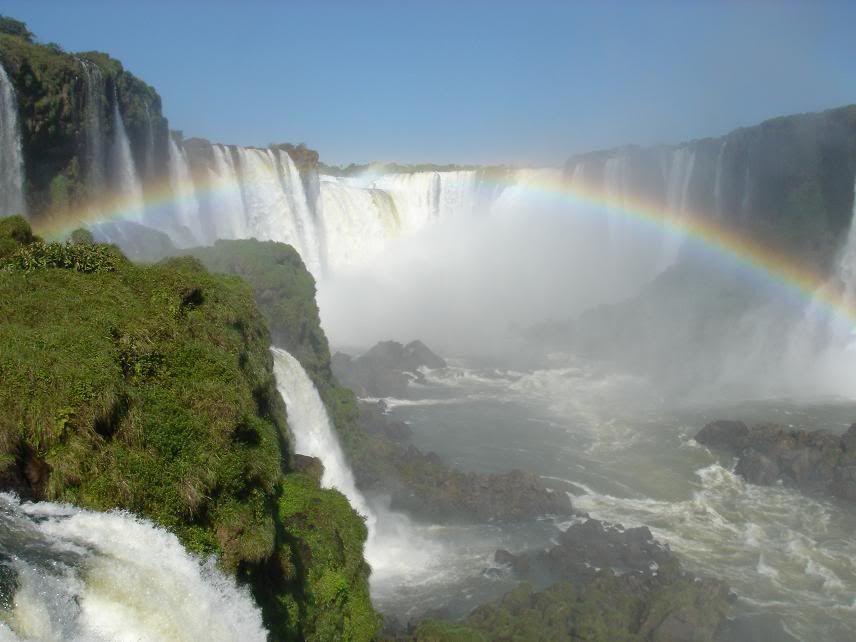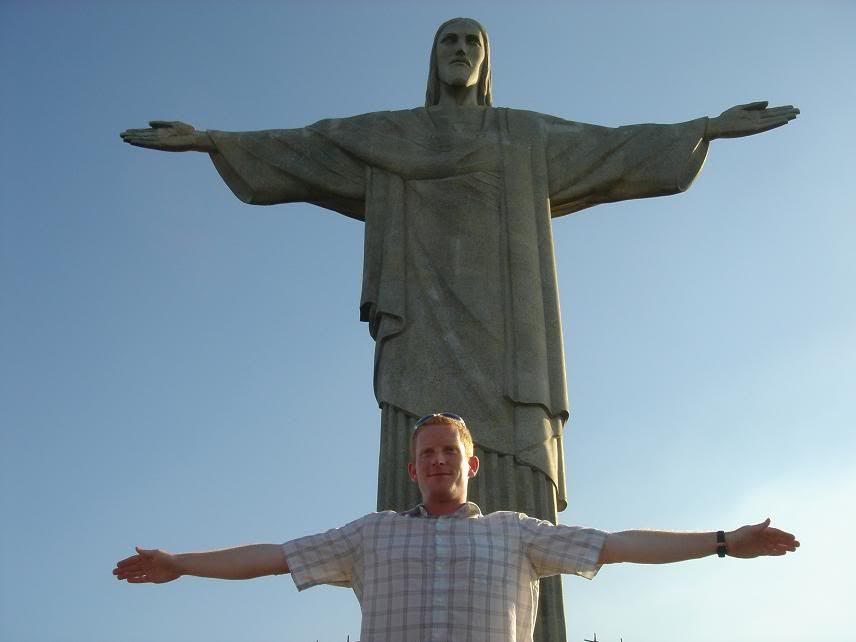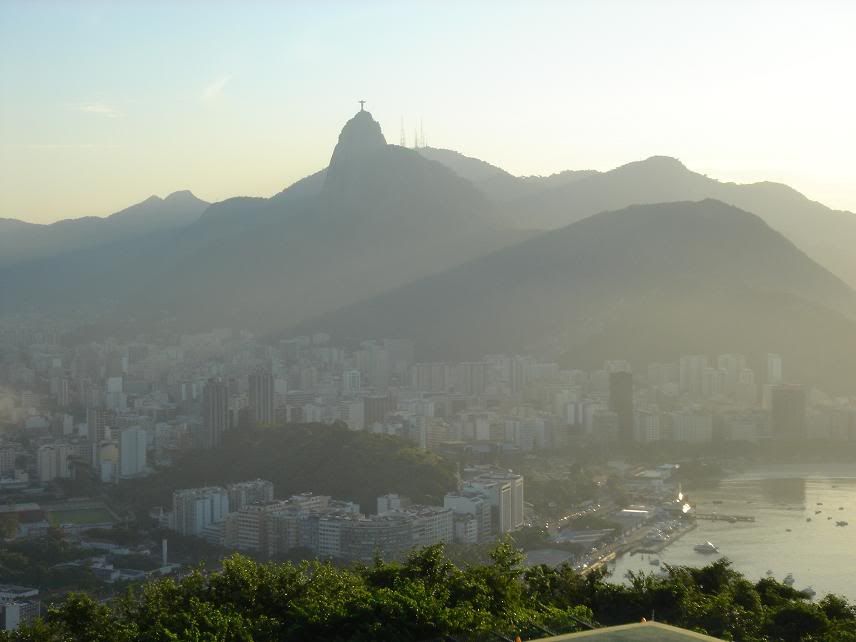Buenos Aires has a funny way of sucking you in and not letting you out, despite the best intentions of your travel plans. I had spent nearly a week in the city by the time I left, waiting fruitlessly for a package Mum had sent me, and it was with some relief that I boarded the ferry to Colonia, across the River Plate in Uruguay, with the intention of visiting Montevideo.
My first impressions of Uruguay were good – Colonia seemed like a relaxed place where there were less people, the cars drove slower, the grass was greener and the buildings smaller. The bus to Montevideo passed through pleasant countryside that was reminiscent of parts of England as parts of Chile had been.
Montevideo centre
Montevideo, capital of Uruguay, differs greatly from it’s neighbouring capital city across the Plate estuary. It's much smaller, and after checking into a really nice hostel, I set out on a walking tour of the city – it is easily possible in an afternoon to see all the sights of the Old City, plus quite a few of the new one. The city was founded in 1726 by the Spanish and although none of the original fortifications remain, there is still some fine Spanish and Italian colonial architecture. The streets were narrower than Buenos Aires and, despite the smaller size of the buildings, it felt more claustrophobic due to the lack of space. There were, as always, many well set out plazas commemorating independence, national heroes and the other usual suspects.
One thing immediately obvious was the national obsession with drinking maté. Almost a third of people walked around clutching a thermos under their arm and their maté gourd in the other. The average Uruguayan is estimate to drink a staggering 570 litres per year – which puts British tea drinking to shame. The average Uruguayan also had a different appearance to an Argentinean – the Argentines retain a lot more European looks – but the people did seem friendlier. Before long I had reached the Mercado del Puerto, a market opposite the port that was famed for it’s excellent (and overpriced) food.
By now night was falling and I made my way back to the hostel, via the beachfront, to find some friends to go out with for the evening. We went to a "Brit-pop" evening at a local bar that night - the 2 bands playing were good although Brit pop it was not. Afterwards I got talking to the guitarist and his girlfriend from one of the bands - we were the only gringos (always good) and they were as curious about us as we were about Uruguayan life. With most of my (non-Spanish speaking) group departed, it was nice to spend time talking to local people in the local language - something that happens far too little on the Gringo Trail.
The following morning I was up early to have a look around the popular Saturday market in the main square in Montevideo. There was a nice atmosphere but I found the large collections of "antiques" and tourist tat a little disheartening - so I got a bus back to Colonia to have a look around before my return ferry. Colonina, founded in 1680 by Portuguese settlers from Brazil, still retains some of it's original fortifications, and my first impressions of the day before were confirmed as I wandered around the quiet cobbled streets of the old town. Several old forts, thick walls and excavated ruins gave the town character and the position on the River Plate was excellent - I could have stayed longer.Colonia Colonia
All too soon I was back on the boat and heading towards the fabled Buenos Aires Saturday night. It was an interesting night – I won’t go into the gory details but the words "fetish club" (it was an accident, honestly) should suffice. By the time I got to bed I was feeling much the worse for wear, and it wasn’t just the beer. I woke in the morning in the clutches of a nasty cold that wouldn’t shake itself for a week. The following few days passed in a blur of lethargy, hankies and sleeping – interspersed with trips to the Venezuelan embassy to sort out a visa (not required... probably), the British embassy (still no package), internet cafes (arranging the Inca Trail for Hannah and I), and various airline and bus offices to sort out my onward travel. I just about managed to visit the Recoleta cemetery one day – a unique mini-city of crypts – and La Boca, a very rundown area with one famously cleaned-up tourist street.
Recoleta cemetery
On Thursday suddenly everything improved; I felt better, I got a flight from Caracas to Lima sorted, I finalised the Inca Trail booking (I think), I bought a bus ticket and, best of all, my package arrived, complete and unopened – I was now proud owner of a new credit card, camera memory card and insurance documents. I was itching to leave Buenos Aires – it’s a nice city, but after almost 2 weeks in one place it was time to move on.
El Caminito, La Boca
My route took me north-eastwards to the state of Misiones, which lies in the Argentinean pan-handle between Paraguay and Brazil, where I intended to visit the remains of the Jesuit missions that flourished here in the 17th and 18th centuries. The "Missions" are what many regard as the most enlightened period of Latin American colonial history. Jesuit Fathers founded around 50 missions in southern Brazil in the early 1600s; however, slave-hunting Portuguese bandits forced them to move some 700km further south – eventually 30 missions were established across modern day Paraguay, Argentina and Brazil in 1627. The local Guaraní Indians who chose to live at the missions were educated and taught to farm - the missions flourished as the co-operative spirit reaped it’s rewards. The success did not go unnoticed by the Spanish and Portuguese governments, who were wary about the natives being anything more than slaves or servants. Once the two countries had settled their border dispute in 1750 (over Brazil, resolved only by Papal decree), several missions were placed under Portugese control, which the missions resisted with arms. Concerned about the apparent power of the Jesuits, the two countries conspired to solve the "missions problem" by expelling the Jesuits from Latin America in the year 1767. Without the guiding hand of the Fathers the missions slowly failed as they were attacked and their lands taken. The last mission was abandoned to the jungle a century later in 1831.
San Ignacio
Using the town of Posadas as my base, I went to San Ignacio de Mini, the best preserved mission left in Argentina. The mission, laid out as all were in a simple plan based on a central square with church, still has many surviving accomodation buildings, living quarters for the priests and church. There is something about this kind of history that never fails to impress me - I loved wandering around the old buildings, imagining how they once had lived, and taking in the quiet atmosphere.
The following day I left Posadas - itself a quiet provincial town - to go to Puerto Iguazú, home to the Iguazú Falls, possibly the most impressive waterfalls in the world. I was due to meet Toni, a friend from the Pachamama backpacker bus in Chile, in a couple of days, so I held back from visiting the falls the first day I arrived - instead chosing to relax by the pool in our casino-turned hostel.
Iguazú at first glance
The falls, spread across the Brazilian-Argetinean border on the Río Iguazú, are 17km upstream of Puerto Iguazú, itself the confluence of the Iguazú and Alto Paraná rivers and the meeting point of Argentina, Brazil and Paraguay. The water cascades over a length of almost 2500m in 275 separate falls over a drop of up to 74 metres. We headed to the Brazilian side first - better for an overview of the whole length, but good for gettign fairly close to La Gargantua del Diablo (The Devil's Throat), the largest fall of them all. After making the trek across the border and to the Park, Toni and I took a walking trail that allowed the Falls to gradually be revealed to us in all their majesty. It was difficult to take in the sheer size and quantity of water - 1750 cubic metres a second in the dry season - but the multitude of rainbows springing from the fine mist, jungle surroundings and wildlife made it feel like a tropical paradise - which I suppose it was. The Gargantua del Diablo itself, reached by a walkway across the top of a smaller fall, was spellbinding - the continual thunder of falls drumming into you and the beauty of so much moving water was hypnotic.
From the Brazil side.....
... hyponotised
The Argentinean side the following day was a different, and maybe better, experience. After completing the circuits that allowed the falls to be viewed from afar, we took a ferry across to an island in the middle to get to a view point right over the second biggest cascade, Salto San Martín (who else?). Afterwards we took a speedboat tour around the falls - and into the base of Salto San Martín - there are no photos or words to describe it, but I do have video! It was excellent fun. Afterwards we went to the final highpoint - the walkway the stopped right above the Gargantua del Diablo, where we could see the volumes of water descending into the bottom of a gorge that probably no-one has ever seen due to the spray. It was fabulous.
Toni and I took the bus to Rio de Janeiro the next day. By this point - the 10th June, I had less than a month until Hannah arrived in Lima, and I reached the conclusion that after Rio I should head as fast as possible to Venezuela, where I had a flight leaving on the 5th of July. We arrived in Rio the next morning and took a taxi to Ipanema, one of the safest districts of Rio - the city is second only to Caracas as the most crime ridden city on the continent, according to Gringo lore. We had the great fortune to pick the same hostel as Noel and Ollie, two Irish brothers also from the Pachamama bus, and we spend a few happy days relaxing on the gorgeous Ipanema beach and getting sunburnt.
The sun always shines on Ipanema....
I missed out many of the things you "should do" in Rio - Brazil is a whole trip in itself as far as I can see, and something to when I can speak some Portuguese. So we went to Copacobana for an open air concert one night - and made total fools of ourselves dancing madly in front of the local cariocas, and spent time on the beach. I can assure those of you who want to know that the idea of the beaches of Rio being filled with lots of tanned, fit bodies basking in the sun is totally correct - body worship is order of the day and sunburn and skin cancer things that happen in other countries.
It had to be done.....
Copacobana and Ipanema
I did manage to fit in a round trip to the Sugar Loaf mountain and Christ the Redeemer statue - a must I suppose - between my visits to Ipanema beach. Despite the hordes of other tourists, the views were excellent and it is probably the only way to get a good impression of the size and layout of Rio. After 4 days in Rio - not long enough, by any stretch - I had to go, taking a flight up to Boa Vista in the far north of the country, and leaving the white sand and sunhine of Ipanema behind to visit better another day.
Sunday, June 19, 2005
The Boy from Ipanema
Subscribe to:
Posts (Atom)
